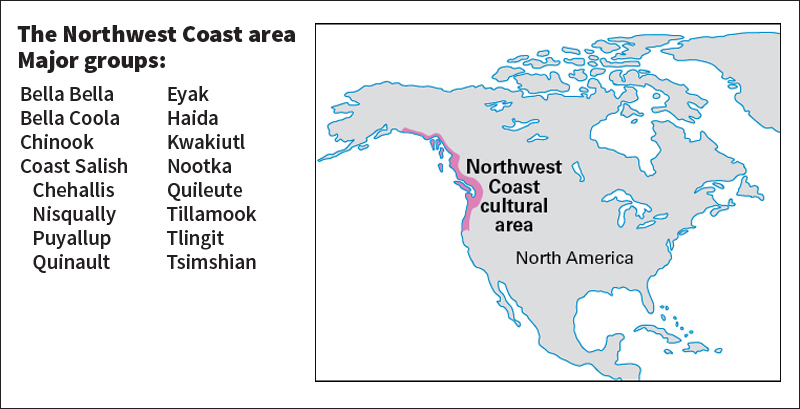Salish << SAY lihsh >> are related groups of native North Americans. They speak forms of the Salish language and were once the main inhabitants in parts of present-day Idaho, Montana, Oregon, and Washington in the United States and British Columbia in Canada. In Canada, they are recognized as a First Nations people. The Salish consist of two major groups—the Coast Salish and the Interior Salish.

The Coast Salish
live along the Northwest Coast. They include such peoples as the Quinault and Nisqually. Their traditional way of life centered around fishing, particularly for salmon. They also hunted small game and gathered roots and berries. During the summer, they lived in small shelters near choice fishing grounds. In the winter, family groups shared large wood buildings known as longhouses. Salish chiefs hosted feasts called potlatches for tribal members and neighboring groups.
There were at least 25,000 Coast Salish when Europeans first came to their lands during the late 1700’s. Most of the Coast Salish in the United States moved to reservations in their traditional territories during the 1850’s. Most Canadian bands were moved to small reserves by 1916. Today, there are several thousand Coast Salish in the United States and Canada. Many of them continue to fish, using modern equipment. Others work in industry and other professions in Washington and British Columbia.
The Interior Salish
live on the plateau east of the Cascade Mountains in the United States and the Coast Range in Canada. Salish who lived in the western part of this region had a culture similar to that of the Coast Salish. During the summer, these Interior Salish lived in mat-covered lodges and spent much of their time fishing. During the winter, they lived in earthen lodges and hunted deer, elk, bear, and other game.
In the eastern part of the interior, such Salish groups as the Flathead adopted many practices of neighboring Plains people. Men hunted buffalo and other large game by horseback, and families lived in tipis made of animal skins when traveling across the plains. These Interior Salish also practice such Plains ceremonies as the sun dance (see Sun dance ).
By about 1800, there were approximately 35,000 Interior Salish in North America. At that time, many worked as fur trappers and traders. The Interior Salish in the United States were placed on reservations between the 1850’s and the 1880’s. Most Canadian bands were moved to reserves by the early 1900’s. Today, there are several thousand Interior Salish in the United States and Canada. Many work in their communities as cattle ranchers, farmers, and loggers. About half have moved to cities.
